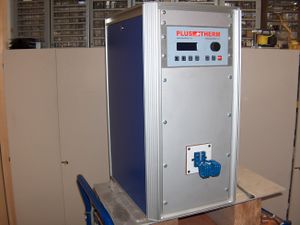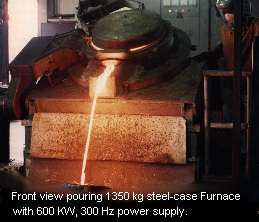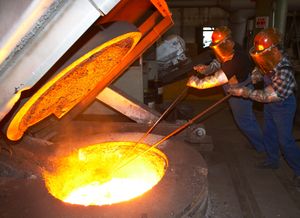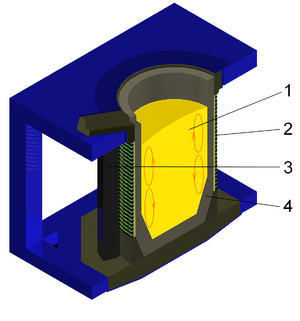فرن الحث الكهربي
ساهم بشكل رئيسي في تحرير هذا المقال
|
فرن الحث الكهربي induction furnace هو فرن كهربائي يولد الحرارة بواسطة تسخين بالحث لوسط موصل (عادة فلز) في بوتقة موضوعة في ملف لولبي solenoid ذي تيار متردد مبرد بالماء. مزايا فرن الحث الكهربائي هي أن عملية الصهر يمكن التحكم فيها تماماً واقتصاده في استهلاك الطاقة ونظافته، بالمقارنة بمعظم الطرق الأخرى لصهر الفلزات. معظم المسابك العصرية تستعمل هذا النوع من الأفران والآن هناك المزيد من مسابك الحديد التي تستبدل أفران الدست بأفران حث لصهر الحديد الزهر، إذ أن الأول ينبعث منه الكثير من الغبار والملوثات الأخرى. وتتراوح سعات أفران الحث من أقل من واحد كيلوگرام إلى مائة طن، ويستخدموا في صهر الحديد والصلب، النحاس، الألومنيوم، والفلزات النفيسة. العيب الرئيسي لاستخدام أفران الحث في المسبك هو انعدام القدرة على التنقية؛ فالمواد المدخلة يجب أن تكون خالية من نواتج الأكسدة وأن تكون بتركيب معروف، وبعض العناصر السبائكية قد تضيع بسبب الأكسدة (ويحب اعادة اضافتها إلى المصهور).
 فرن حث شبه موصل يستخدم في عملية صناعية |
الأنواع
In the coreless type,[1] metal is placed in a crucible surrounded by a water-cooled alternating current solenoid coil. A channel-type induction furnace has a loop of molten metal, which forms a single-turn secondary winding through an iron core.[2][3]
التشغيل
An induction furnace consists of a nonconductive crucible holding the charge of metal to be melted, surrounded by a coil of copper wire. A powerful alternating current flows through the wire. The coil creates a rapidly reversing magnetic field that penetrates the metal. The magnetic field induces eddy currents, circular electric currents, inside the metal, by electromagnetic induction.[4] The eddy currents, flowing through the electrical resistance of the bulk metal, heat it by Joule heating. In ferromagnetic materials like iron, the material may also be heated by magnetic hysteresis, the reversal of the molecular magnetic dipoles in the metal. Once melted, the eddy currents cause vigorous stirring of the melt, assuring good mixing.
An advantage of induction heating is that the heat is generated within the furnace's charge itself rather than applied by a burning fuel or other external heat source, which can be important in applications where contamination is an issue.
Operating frequencies range from utility frequency (50 or 60 Hz) to 400 kHz or higher, usually depending on the material being melted, the capacity (volume) of the furnace and the melting speed required. Generally, the smaller the volume of the melts, the higher the frequency of the furnace used; this is due to the skin depth which is a measure of the distance an alternating current can penetrate beneath the surface of a conductor. For the same conductivity, the higher frequencies have a shallow skin depth—that is less penetration into the melt. Lower frequencies can generate stirring or turbulence in the metal.
A preheated, one-ton furnace melting iron can melt cold charge to tapping readiness within an hour. Power supplies range from 10 kW to 42 MW, with melt sizes of 20 kg to 65 tons of metal respectively.[بحاجة لمصدر]
An operating induction furnace usually emits a hum or whine (due to fluctuating magnetic forces and magnetostriction), the pitch of which can be used by operators to identify whether the furnace is operating correctly or at what power level.[بحاجة لمصدر]
التبطين الحراري
There is a disposable refractory lining used during casting.
انظر أيضاً
- الأفران
- فرن القوس الكهربي - لنوع آخر من الأفران الكهربائية، يستخدم في المسابك الأكبر وعمليات صناعة الصلب في mini-mill
- Crematory
- Electric arc furnace—for another type of electric furnace, used in larger foundries and mini-mill steelmaking operations
- Electric arc furnace—for another type of electric furnace, used in larger foundries and mini-mill steelmaking operations
المصادر
- Foseco Ferrous Foundryman's Handbook, Elsevier, 2000
المراجع
- ^ Robiette, A G (1935). "V: Coreless Induction Furnaces". Electric Melting Practice. Charles Griffin & Co. pp. 153–252.
- ^ Robiette 1935 "Chapter IV: Channel Type or 'Low Frequency' Induction Furnaces", pp. 153–252
- ^ Induction and Dielectric Heating. Electricity and Productivity Series, Nº6. British Electrical Development Association. 1962. pp. 8–9.
- ^ Bhattacharya, S.K. (2009). Fundamentals Of Power Electronics. Vikas Publishing House Pvt. pp. 142–143. ISBN 978-8125918530.
للاستزادة
- Brown, John (2000). Foseco Ferrous Foundryman's Handbook (11th ed.). Butterworth-Heinemann. ISBN 978-0750642842.
وصلات خارجية
- "How Induction Furnace Are Making It Hot For The Axis", Popular Science, November 1943. Detailed article on the basics with numerous illustrations



